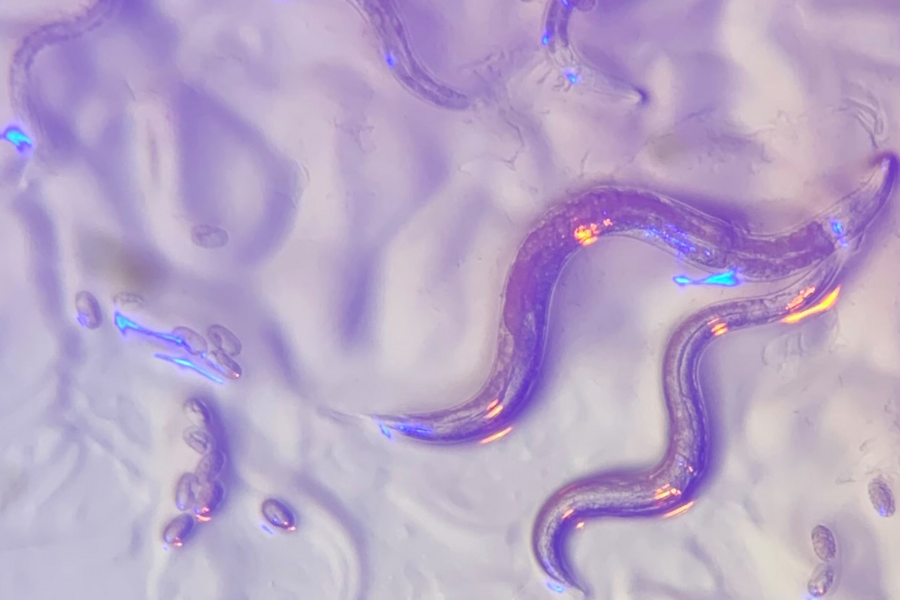Roundworms are also known as nematodes, belonging to the phylum “Nematoda”. They are a diverse group of species ranging in size from microorganisms to several metres long.
Introduce Roundworms are what type of biohazards?
Shape
Roundworms are long,unsegmented, bilaterally symmetrical with a cylindrical body with tapered ends. They are triploblastic, having three layers of skin. The outer one is cuticle which sheds and leads to their growth. They have longitudinal muscles which help them in movement.
Organ system
They have a proper digestive system having two ends, at one end there is mouth and at other end there is anus. They also have reproductive and nervous systems but the respiration takes place through anaerobic pathway i.e: in the absence of oxygen.
Habitat
Roundworms are found in several habitats including soil,fresh water, marine water, below the earth to tropical regions and as parasites in or on the human body and animals.
Transmission
Roundworms are usually transmitted by fecal-oral route. When an infected individual excretes his faeces, it may contain eggs of roundworms and if this is ingested by a non infected individual by any means, the infection then transmitted.
Poor hygiene, improper hand washing, also walking bare feet in soil are the sources of fecal-oral transmission.
People may be infected by eating raw or undercooked food contaminated with roundworm larvae or eggs.Similarly contaminated water can also be a source of transmission.
If you have a pet, which has a roundworm infection and you handle his poop and if accidently you touch your mouth, you can also get affected.
Hookworms which are a type of roundworm can be penetrated through skin if you sit in contaminated soil bare feet.
Why Roundworms are considered as biohazards?
There are few roundworms that are free-living and feed on bacteria, algae, fecal material, dead organisms and are not hazardous while other roundworms depend on their host and infect them.
Roundworms may be present in different organs and tissues of humans and animals.
For example:
Ascariasis
It is caused by a roundworm called ‘Ascaris Lumbricoides’ in human and mostly present in intestines and may cause:
- Abdominal pain
- Bloating
- Nausea and vomiting
- Diarrhoea, sometimes containing worms or their eggs.
- Malnutrition
Enterobiasis
It is caused by ‘enterobius vermicularis’. They are commonly called pinworms, usually affect children, and cause:
- Itching around the anal area at night.
- Discomfort
- Irritability
- Difficulty sleeping
- Weight loss
Ancylostomiasis/ Hookworm disease
It is caused by parasites commonly known as hookworms which are considered as blood feeding parasites. It occurs mostly by two species ‘Ancylostoma duodenale’ and ‘Necator americanus’.
This infection usually occurs when a person walks on bare feet on soil contaminated with larvae of hookworms.
When larva penetrates through skin it causes an allergic reaction( ground itch) and later on the larva moves to lungs by bloodstream, then travel to intestines and causes:
- Abdominal pain
- Nausea
- Vomiting
- Anorexia
- Flatulence
- Diarrhoea
- Weight loss
- Iron deficiency Anaemia due to chronic blood loss
- Weakness
If it occurs in pregnant women it can cause growth retardation of the fetus.
Trichuriasis
It is caused by ‘Trichuris Trichuria’, which is mainly found in tropical and subtropical regions
They infect the large intestine e.g Colon and transmitted by contaminated soil, contaminated fruits and vegetables and poor hygiene. They cause:
- Abdominal pain
- Bloody diarrhoea
- Weight loss
- Malnutrition
- Growth retardation in children
Filariasis
This is caused by ‘Wuchereria Bancrofti’. This is transmitted when an infected mosquito bites the human. It involves the lymphatic system and causes:
- Swelling of limbs
- Numbness
- Pain
- Disability
- Difficult to move
In men it can also cause swelling of scrotum called hydrocoele.
Roundworm infection in animals
Not only humans get infected with parasitic roundworms. Some animals, especially cats and dogs can also have roundworm infection.
Cats and dogs of any age can get infected but usually kittens and puppies in their young age get infected. Female cats and dogs usually transmit infection while giving birth.
Two species that infect puppies and kittens are ‘Toxocara canis’ and ‘Toxocara cati’. Infected animals show weight loss, diarrhoea and decreased appetite.
How does nematodes affect agriculture?
Roundworms are harmful not just for humans and animals but also for plants,crops and agriculture.
There are few free living roundworms that are harmless and do not feed on hosts while others are detrimental for crops and plants.
The parasitic nematode attacks the roots of the plants and drains the nutrients from the roots. This causes stunted growth and significant damage to crop yields.
Some nematodes also act as a vector to transfer plant illnesses from one plant to another. The nematodes live for a long time in soils and affect the cultivation. Once found in soil, they multiply rapidly and their eradication becomes very difficult.
Who is at risk of roundworm infections?
- Underdeveloped countries people
- People living with poverty
- Poor hygiene practice
- Close contact spaces like prison
- Warm climate


